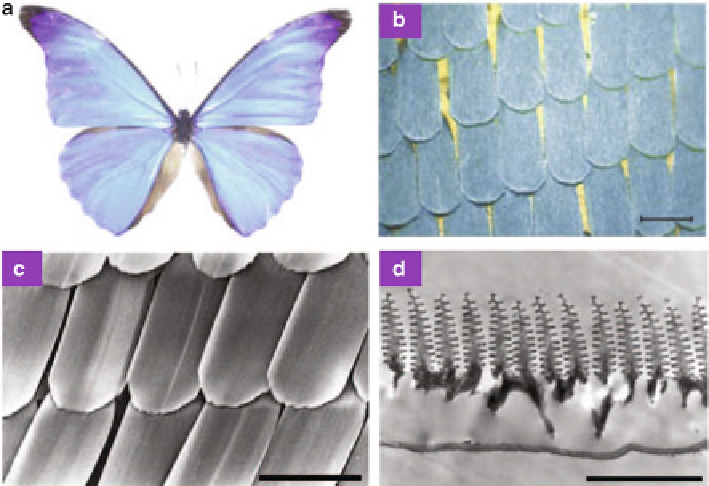Biomedical Engineering Reference
In-Depth Information
Fig. 8.14
(
a
) Optical image of the butterfly
M. rhetenor
.(
b
) Optical microscopic image of the
dorsal wing showing the ordered arrangement of a single layer of ground scales. (
c
)SEMimageof
the scales. (
d
) Cross-sectional TEM image of an iridescent ground scale. Scale bars: (
b
) 100
m;
(
c
) 120
m; and (
d
)3
m (Reproduced from [
60
])
height and the small ridge width can eliminate the interference between scattered
light from the neighboring ridges, leading to a weak viewing-angle dependence for
the blue structural color.
In other butterfly species, e.g.,
Ancyluris meliboeus
, similar discrete multilayers
were also found, responsible for the wing coloration [
66
]. These multilayers are
highly titled to the base of scales, leading to a strong color flicker contrast from
minimal wing movement.
In addition to insects, multilayer structures are also present in spiders. The
jumping spider
Cosmophasis umbratica
is a highly ornamented species from
Singapore, as shown in Fig.
8.15
. Many parts of the male's body are covered with
green-orange scales. These scales possess a chitin-air-chitin sandwich structure,
which can reflect both the visible and UV light [
67
]. This spider has an intriguing
sexual recognition system that involves the use of UV light. During courtship, the
males display their reflecting parts in front of the females. The females tend to
accept those males who can reflect more UV light [
68
].
Although rare, multilayer structures exist also in plants [
69
-
76
]. Blue-green
iridescent leaves can be usually found in certain understory plants growing in moist
and low light environments of tropical rainforests. The first example of a multilayer
in plants was found in the leaves of the lycophyte
Selaginella willdenowii
[
69
,
70
].

